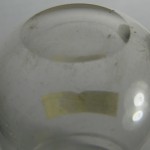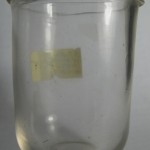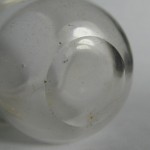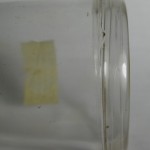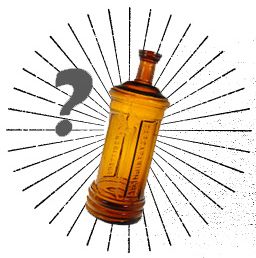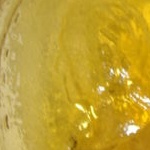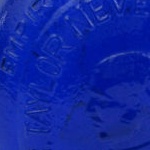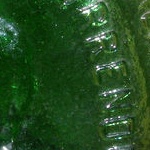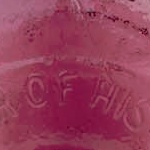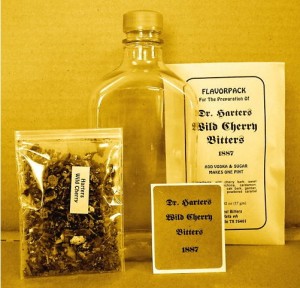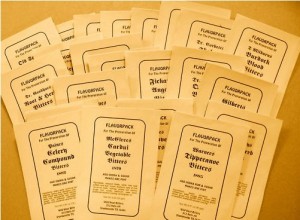Here are pictures of a clear glass leeching cup from the earlier part of the 19th century. It is 2-3/4″ tall and about 2″ in diameter. It’s a hand blown piece with folded rim and a polished pontil.
Washington Taylor, Father of His Country flasks
The Washington Taylor flask described by McKearin as GI-37 is a fairly common item whether they be the original 19th century bottle or the abundantly reproduced 20th century copy. Determining whether one is a true historical flask or just a replica made by the Clevenger Brothers or other late 20th century manufacturer is not always an easy task for the non-collector.
The #37 quart mold is the first of 32 different variations thought to have been made at either Dyottsville Glass Works in Philadelphia, PA or Lockport Glass Works in Lockport, NY. Original bottles exist both as smooth base or with a pontil scar; lip finishes vary from the common shear to single or double collar and even in some cases a square or tapered collar.
Let’s compare:
(1) Some modern replicas are quite different, in shape, size and embossing. It’s the Clevenger Glass Works product which is fairly faithful from the original and causes the greatest confusion. The differences are subtle and in some cases only the experienced collector is going to be able to tell the difference.
(2) Originals were produced in a wide variety of colors, some of which are rarely seen in 19th century bottles. Modern pieces are found in both the common aqua color as well as brilliant green, yellow, puce and cobalt blue, among others. Colors other than aqua should be an immediate warning sign that the bottle is likely modern.
(3) Modern and old are found in smooth base or with pontil scars. Modern and old can have a plain sheared lip or some type of lip finish.
(4) Both modern and old can show similar thickness of glass; similar straw marks, bubbles and potstones. A common trait in modern examples is the bumpy, “orange peel” effect to the glass surface.
(5) The junction of the neck and body of the modern bottles is often abrupt. As you see in the photos below, the modern examples look like the neck was just jammed onto the bottle. In 19th century bottles, the transition is smooth without a seam or crease.
(6) The bases of 19th century examples are either flat or with a large oval recess. Modern examples have a precisely round concave recess in the bottom center. In some cases, the round recess is obscured by the pontil scar.
Value
Reproductions are abundant and do not have much value. Figure $5-20 decorative value. Originals without damage begin in the $75-100 range for aqua and can reach into the $20-30 thousand dollar range for a great example in a rare color. $2-6 thousand is more typical for a good quality colored example.
Antique Bottle Forums
Here is my list of all current discussion forums which focus on antique bottles. Allow me to be a bit biased and begin with Historic Glasshouse’s
- Historic Glasshouse forum
- Antique-bottles.net
- Mr. Bottles Forum – http://www.mrbottles.com/FORUM/default.asp
- Australian Bottle Forum – http://ozbottleforum.com/
- Treasure Quest forum – http://www.treasurequestxlt.com/community/index.php?forums/antique-bottle-talk.273/
- Fruit Jar Forum – http://www.hoosierjar.com/jartalk/index
- BottleCollectors Group on Yahoo Groups – http://groups.yahoo.com/group/bottlecollectors/
Damage to Antique Bottles (UNFINISHED)
this will cover types of damage:
– potstone
– crack
– repaired damage
– lacquer sprayed
– oiled finish to cover stain (Scotts Liquid Gold)
– epoxy fill
– cut and reglued
– applied embossing
Antique Bottle Condition (UNFINISHED)
this page will cover
– the importance of condition
– what does MINT really mean?
– general grades w/ descriptions (perfect, near perfect, average, dug/unearthed, damaged)
– how does damage affect value?
Weeks and Potter – Wholesale Druggists – Boston, MA
Weeks and Potter was a large company operating in Boston at 360 Washington Street in the late 19th and early 20th century. Bottle collectors will know them first for such popular items such as SANFORD’S JAMAICA GINGER, Sanford’s Radical Cure, CUTICURA and others.
The company later became the Potter Drug and Chemical Company.
Andrew Weeks and Warren Potter sold both retail and wholesale drugs in their business careers and represented many brands as an “agent” (today we would call them a distributor) These brands include Fetridge’s Balm of 1000 Flowers, The Ayer Company (think Ayer’s Sarsaparilla), Kidder & Osgood, and Schenck’s Pulmonic Balsam.
I own a hardcover catalog from the company from the late 19th c. which has about 150 pages detailing their inventory. Hope to get more info from that catalog online in the future.
Here are some other items of note from Weeks & Potter:
Neptune’s Nectar
The New Appetizer and cur for Dyspepsia and Billiousness. Distilled from Sea Products, and highly recommended by the best physicians. Put up in attractive non-breakable packages, two dozen to a case. Sells at sight. Pays handsome profits to the retailer. A fine colored lithograph with every five case order. Retail price 25 cents.
Sanford’s Camphor Ice
The trade should always be ready to purchase an article which sells and pays a large profit. Such an article is “Sanford’s Camphor Ice” Neatly and handsomely put up, it is an ornament to any counter.
Beef, Iron and Wine
Our preparation has been much improved since we first introduced it, and we are ready to guarantee it equal, at least, to any make on the market. As we are large importers of wines, we are able to secure a good selection, and the wine used in our “Beef, Iron and Wine” is one of the best flavored wines we keep. You may find it economical to handle this instead of your own make. You should look into the matter, get your figures and samples and see what we can do. We will bottle it for you, with YOUR label, at $4.50 per dozen full pints, if you order 12 dozen at a time, or we will sell you in bulk in quantity as desired.
Of Note
Companies like this provided private label products for local druggists and merchants. This helps explain the large number of products found with labels from small towns. There were not thousands of manufacturers but I suspect there was quite a bit of private labeling of products at this time. Of course the practice continues today…
Cuticura
Cuticura is the great Skin Cure, a medicinal Jelly. Price 50 cents. Large boxes $1.00
Cuticura Resolvent is the new Blood Purifier. Pitched as “The Cuticura System of resolving and eliminating All Constitutional Humors” Price $1.00
Case Gin Bottles
Case gin bottles, also known as taper gins, were a common style used from the 17th through early 20th centuries. The body is square in cross section and in all cases will taper from a wide shoulder to a narrower cross-section at the base. This form is almost always found in olive green color ranging from translucent to opaque. On occasion, you will encounter examples in clear and other green hues. Other colors are rare – I have seen an example or two in cobalt blue over the years.
For an superb review of facts and references related to case gins, see Bill Lindsey’s liquor/spirits bottle page. Scroll way down to the Case Gin section.
Dale Murschell’s book on Wistarburgh glass discusses case gins made at this 17th century glassworks in New Jersey. As Dale states, Wistar advertised the form for sale and they were listed in his Will Inventory. He shows many fragments and examples and discusses attributing form variants to the factory. In short, Wistar examples are thought to be those which are quite boxy in form with a very square shoulder and a pronounced arc across the base edges. This is a simplification of the data so be sure to consult with Dale’s book for far greater detail.
Thanks to Dale’s book and a discussion with Rick Ciralli earlier this year, I was inspired to snap a bunch of photos of gins at the Coventry Bottle Show in May. There was a great selection of case gins there including a period chest full of gins.
Here are the pictures: (click images to see larger views)
[nggallery id=5]
The McKearin Historical Flask Groups
Group I – Portrait Flasks
Numbers 1 through 61 are Washington Flasks
Numbers 62 through 79a cover Adams, Harrison, Jackson and Taylor
Numbers 80 through 93 are Lafayette
Numbers 94 through 98 are Franklin
Numbers 99 through 107a are Jenny Lind
Other portrait flasks are listed in molds 111 through 131
Group II – American Eagle Flasks
There are 144 molds in this group
Group III – Cornucopia Flasks
18 Cornucopia molds
Group IV – Masonic Flasks
There are 43 molds in the Masonic flask group.
Group V – Railroad Flasks
12 flasks
Group VI – Baltimore Monument Flasks
7 molds
Group VII – Cabin bottles
6 molds in this group
Tom Haunton officially extended this group and added molds as documented in his book, Tippecanoe and EG Booz, Too
Group VIII – Sunburst Flasks
There are 30 flasks in the sunburst group.
Group IX – Scroll or Violin Flasks
There are 52 in the Scroll group.
Group X – Miscellaneous Flasks
33 flasks include Good Game, Sloop, Murdock & Cassel, Summer/Winter, Jared Spencer, American System, Stoddard Flag among others. This was the final group as documented in American Glass. The following groups were added with the publication of American Bottles and Flasks and Their Ancestry:
Group XI – Pike’s Peak Flasks
54 molds
Group XII – Shield and Clasped Hands
There are 43 molds listed in this group. There are several unlisted flasks known.
Group XIII – Pictorial Flasks from the 1850 to 1880 Period
Includes over 90 flasks. Flora Temple, Horseman/Hound, Sheaf of Wheat, Baltimore Glass Works/Anchor and others.
Group XIV – Traveler’s Companion Flasks
9 flasks
Group XV – “Lettered” Flasks
These are mostly flasks with embossing indicating a particular glass works. 28 molds.
Old Bitters in a New Bottle
I recently exchanged emails with John Keys after stumbling upon his bitters ingredients auctions on ebay. For about $10, you can recreate the 19th century experience of the bitters consumer – with great historical accuracy. His product line is called Wild West Bitters – you will receive the herbs and spices used in many of the popular bitters formulations known well to antique bitters bottle collectors today.
The unique ingredient packs from Wild West Bitters make it possible to reproduce, in one’s own kitchen, many of the bitters that were sold in the patent medicine era of the late 1800s. The product line is the result of 40 years’ research on the part of John David Keys of Stephenville, Texas, who felt that antique bottle collectors and many others might find it fascinating to experience just what was originally inside those bottles.
Keys scoured through distillers’ formularies, pharmaceutical dispensatories, period advertisements, medical writings and judicial reports in his quest for reconstructing the formulas, or recipes, for the bitters. Chromatographic chemical analysis of rare surviving bottle contents was also employed. Lastly, Keys relied on subjective assumption for many of the bitters.
Claimed originally as having miraculous curative powers, most of the patent bitters of the 1800s were in reality simple stomachic digestives. In fact many of them were consumed as “recreational” beverages, much like Jägermeister is today. The bitters that can be prepared from the Wild West Bitters ingredient packs are intended as “recreational” beverages, and no medicinal properties are implied. Keys himself regards the line as “history you can recreate, experience and share”.
Fifty varieties of Wild West Bitters ingredient packs are available exclusively on eBay. Wholesale sales are offered for 12 of the more popular items.
For example, The Dr. Harter’s Wild Cherry Bitters is based on an 1887 formula whose ingredients are: wild cherry bark, sweet orange peel, cinchona bark,cardamom, canada snakeroot, gentian, cinnamon, cloves,powdered caramel coloring, bitter almond oil (natural benzaldehyde).
Is this not amazing?
Old Home Bitters
This exceptionally large square cabin-shaped bitters bottle is modern. It was made in the 1970s for a North Carolina furniture company for use as a lamp. Most are found with a hole drilled in the base. They are usually seen in amber but also occasionally green.
The bottle reads DOC DUNNING / OLD HOME BITTERS / GREENSBORO N. CAROLINA on three of the four indented panels. It is about 14″ tall with a 5″ square body. You will find in listed in the Ring/Ham Bitters book as O34.
They are attractive and do make a nice lamp, but they are not particularly valuable. Figure around $50 for a drilled example; more if undrilled.
The Originals
This is a reproduction of similar bottles with similar embossing.
First is O35 which is embossed OLD HOME BITTERS / WHEELING, W. VA. / LAUGHLIN & BUSHFIELD. This is an amber cabin which is around 10″ tall.
Second is O36 which differs from O35 only in that it is marked LAUGHLIN / SMITH & CO. This is apparently the earlier of the two original bottles. This is also found in amber and is a bit under 10″ tall.
These two original bottles are worth $1-4 thousand.
